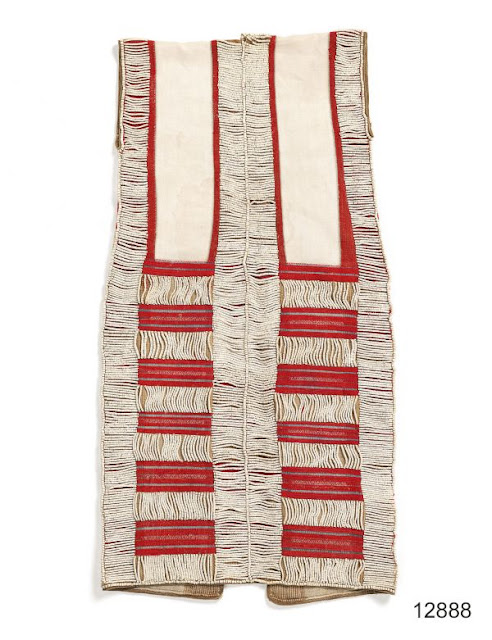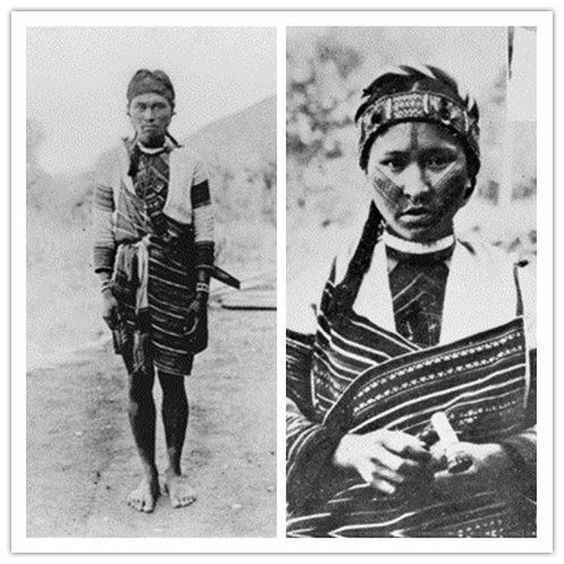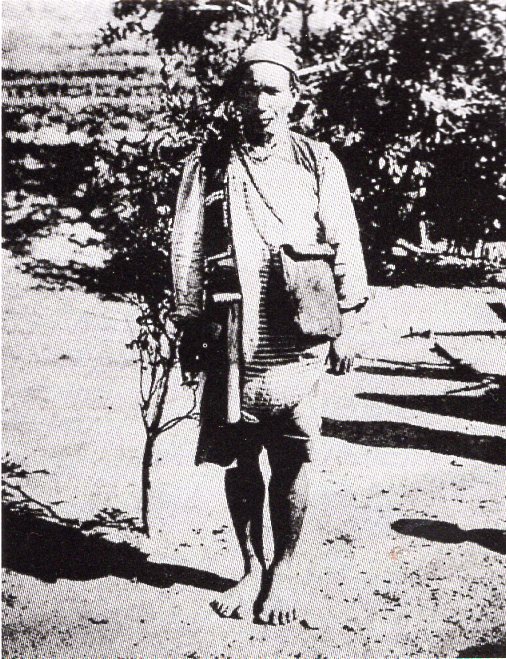Hello all
Today I will talk about the costume of the native peoples of the island of Taiwan, or Formosa. This is the homeland of the Austronesian Peoples. Archeological evidence puts the ancestors of these people on Taiwan at least 3000 BC. The Austronesian Language family has 10 major linguistic branches. Nine of them are restricted to Taiwan. The tenth is the Malayo-Polynesian branch. The ancient Austronesians came out of Taiwan to populate what is now the Philippines and Indonesia, and then west to Madagascar. A later surge travelled east, to Melanesia, Micronesia and Polynesia. Today this language family is found from Madagascar east to Rapa Nui, and from Hawaii south to New Zealand. The term Austronesia means 'southern islands', and indeed these languages are almost completely confined to the islands of the Indian and Pacific Oceans; the only exceptions being Malay, spoken on the southern part of the Malay Peninsula, and the Chamic languages, which are spoken in southern Vietnam and neighboring parts of Cambodia.
Today the majority of people who live on Taiwan are Han Chinese. They came over from the mainland during the Dutch Colonial period in the 17th cent. mainly as agricultural workers. Most of the immigrants were Hoklo from Fujian, with some Hakka from Guangdong. Both of these languages are still spoken by significant parts of the population of Taiwan. Starting in about 1683 the island became incorporated into the Qing Dynasty Empire, until 1895, when it was ceded to the Japanese Empire. The Japanese pursued a policy of forced assimilation in regards to the Aboriginal Peoples. Several of the smaller peoples hid themselves among larger ones for protection during this period. In 1945 the nationalist Government of the Republic of China took control, of Taiwan, and soon afterwards was driven from the mainland by the Communists. This led to a large influx of Mandarin Speaking Han Chinese. Since then Taiwan has been a de facto independent nation.
Today the government officially recognizes 16 nationalities of Indigenous People in Taiwan. There are several other groups which have not as yet received official recognition. Members of the officially recognized groups number about 569,000, with perhaps a further 230,000 belonging to groups not as yet recognized. This does not include people of mixed ancestry whose forbearers intermarried with the Hoklo and the Hakka. Some of these are collectively referred to as Pingpu, or Aborigines of the Western Plains.
https://en.wikipedia.org/wiki/Taiwanese_indigenous_peoples
https://en.wikipedia.org/wiki/Formosan_languages
Here is a map of the original territories of the Indigenous peoples.
Here is a map of their current distribution.
As you can see, the people of the western plains underwent much more assimilation than the people of the eastern mountains. In fact, the Communist Government of mainland China lumps all of these peoples under the term 'Gaoshan', which means 'High Mountain' People. This term is seldom heard in Taiwan.
https://en.wikipedia.org/wiki/Atayal_people
https://www.dmtip.gov.tw/web/en/page/detail?nid=5
This group is also called Tayal or Tayan, 泰雅 in Chinese. There are approximately 100,000 of them, divided into several subgroups using two main dialects. This makes them the third largest Indigenous Taiwanese people. This group has been recognized since the time of the Japanese occupation. They dwell in the north central part of Taiwan, and are at home in 79 villages. They originally lived further west, in the upper plains of the Zhuoshui river, but in the 17th cent. were pushed east into the mountains by Han Chinese encroachment. The Atayal, like many of the indigenous Taiwanese, are proficient weavers. The Seediq and the Truku were formerly classified as subgroups of the Atayal. The other groups which I will show today have cultural and costume similarities to the Atayal.
The details of the costume vary by subgroup, but you can see some of the unusual garments which are typical of the Taiwanese aborigines. One is the plastron, or chest covering, which is an ornamented square of cloth which is worn on the front of the chest diagonally. This can be seen on both men and women, with different ornamentation.
You can see the man above wearing separate sleeves with this garment. This may be worn by either gender.
A long open fronted tunic, with or without sleeves is often worn by both genders.
Women wear wrap skirts.
Women also wear leggings which tie around the lower legs, below the knee.
Both genders wear a 'square robe', or mantle which hangs over one shoulder for formal events.
Both men and women traditionally wore facial tattoos.
Of course, sashes, headbands, necklaces, etc are also part of the costume.
Just a few more images of the Atayal
Saisiyat
https://en.wikipedia.org/wiki/Saisiyat_people
https://www.dmtip.gov.tw/web/en/page/detail?nid=11
Also spelled Saisiat, or 賽夏 in Chinese. These people number somewhat over 5000, and have been recognized as a distinct group since 1919. They inhabit the northwest of Taiwan, formerly in a wider area in the northwestern plains, but more recently they have been pushed into two valleys in the mountains. They are famous for their biannual festival called Pasta'ay. Their legends claim that a man who was caught in the primordial flood floated by Taiwan on a loom . A local god Otspoehobong caught the man, and dismembered him. After an incantation, the god threw pieces of his intestines into the sea, and they became the ancestral Taiwanese. Then he threw pieces of the bones into the sea, and they became the Atayal, hard and indomitable. Then he threw the pieces of the flesh into the sea, and they became the Saisiyat. The Saisiyat speak a distinctive language, but their costume is similar to that of the Atayal.
Seediq
https://en.wikipedia.org/wiki/Seediq_people
The Seediq, 賽德克族 in Chinese, were formerly classified as part of the Atayal people, and were recognized as a separate group in 2008. They live in Nantou and Hualien counties, southwest of the Atayal, and north of the Thao, who live around Sun Moon Lake. The Seediq famously resisted all attempts of the Japanese to encroach on their territory, when they controlled Taiwan. This resulted in several clashes with the Japanese, who did not come off well, and retaliated with excessive and bloody action. The most famous of these was the Wushe incident in 1930, about which a couple of movies and contemporary music albums were made.
Truku
https://en.wikipedia.org/wiki/Taroko_people
https://www.dmtip.gov.tw/web/en/page/detail?nid=14
The Truku, or Taroko, 太魯閣族 in Chinese, were formerly considered to be a subgroup of the Atayal. They speak a dialect of the Seeliq language. There are about 20,000 of them. They were officially recognized as a separate people in 2004. They live to the southeast of the Atayal, next to the coast, just north of the Sakizaya.
Thank you for reading, I hope that you have found this to be interesting and informative. I will continue with the central and southern peoples in my next articles.
Roman K
email; rkozakand@aol.com











































































































































Great article. I like your theme.Thanks for sharing this informative content with us .what i m looking earlier keep up the good work it.
ReplyDeleteDear Roman: So glad to hear from you. It is clear you have been researching like crazy - I am always astounded by the variety in a few pieces of cloth. Thank you. Charlotte in California
ReplyDeletewow these are so cool! I hope you'll look at Malaysia in the future!
ReplyDeleteCostumes of the Indigenous Taiwanese are pieces of clothing, including skirts, jackets, and christine barker author pajamas, that were made by indigenous Taiwanese people. These pieces of clothing were made to help preserve the culture of the indigenous Taiwanese people and were passed down through generations. The clothing that the indigenous Taiwanese people made was originally only used for celebrations and important events, but now these pieces of clothing are commonly worn for everyday life as well.
ReplyDelete